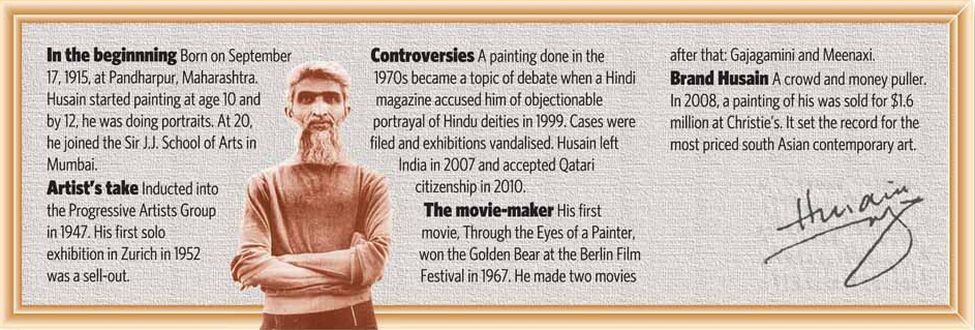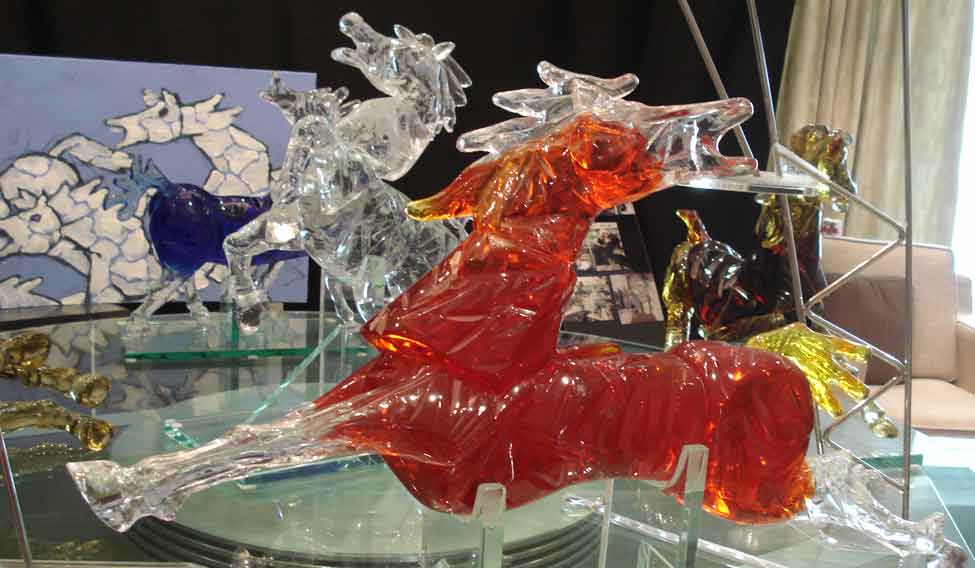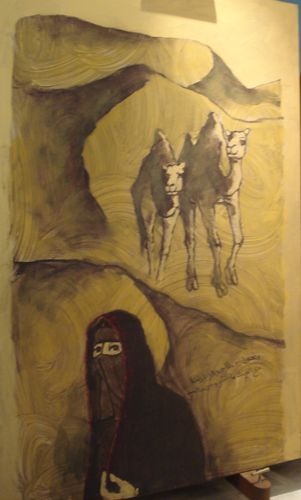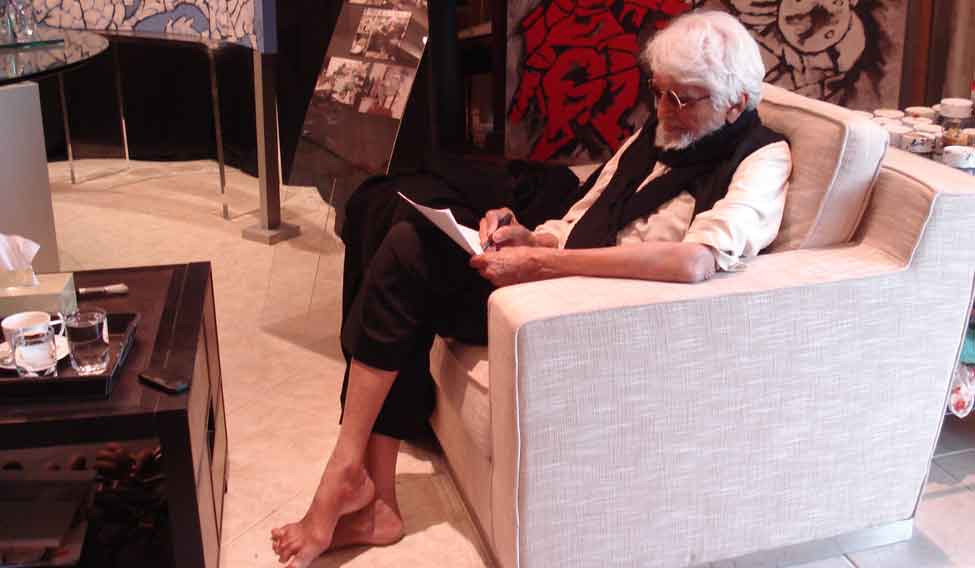Husain: The press has written all about me, what more do you want to know?
Me: About your work in Qatar, sir.
Husain: Theek hai, kal milenge. 3:30 p.m.
The address is Villa #3, Street 16, West Bay Lagoon Complex. I reach the complex’s South Gate, a simple cast iron structure manned by uniformed guards. They perk up as my father’s black Pajero stops at the barricade. No, they insist in broken English, no one goes in unless the host sends somebody to escort you.
After a short wait, a white Cadillac pulls up next to me. In the driving seat is Syed Alawi Elanthical, M.F. Husain’s man Friday in Doha. As I tail the Cadillac to Husain’s villa, I understand it is not for nothing that the West Bay Lagoon Complex is listed among Qatar’s ambitious housing projects.
“He does not usually let journalists into his home. You are the first one to go there,” a source close to Husain had told me.
The desert sun is harsh and unforgiving, bleaching all that it touches to sand, beige and white. But as I enter Villa #3, I am attacked by a riot of blues, greens, browns, oranges… all standing out in defiance against the beige interiors. Easels tacked with canvases line the hallway, some taller than the 5ft me, some completed,others half done as if the imaginative vein had petered out. Four glass horses―blue, red, clear and yellow―stand on a glass-and-steel table. Paint brushes as long as walking sticks and carelessly placed bottles of paint complete the drawing room.
Syed asks me to make myself comfortable, as sahab will join me in a moment. “He is known not to keep appointments,” I recollect a colleague’s warning and nervously settle down on a chair next to a beige sofa. Caught between his master and an eager journalist, Syed seems restless and after about 20 minutes knocks on a bedroom door off the drawing room. He holds a whispered conference with the occupant, who was apparently enjoying a siesta. Within a minute, a silver mop of hair pops up at the door. With his characteristic impish grin, Maqbool Fida Husain greets me with a namaste, as if apologetic about the delay.

The 94-year-old reminds me of the sketch of a sparrow I was shown in Sunday School. It had a mossy bough of a tree leaning over a roaring cataract. On the bough, drenched by the spray, sat a sparrow in her tiny nest. Oblivious to the thundering falls below her, the bright-eyed bird was trilling merrily. Music amidst mayhem. My teacher said the picture best illustrated faith. That is Husain for me―bright-eyed, creative and cheerfully defiant of what the world thought and wrote of him.
After years of self-imposed exile, Husain sahab has settled in his new home, a gift from the Emir Sheikh Hamad bin Khalifa al-Thani. His acceptance of the Qatari citizenship evoked strong reactions in India. Some said ‘good, finally the nomad has pitched a tent’; some were apologetic and felt the need to say ‘you are always welcome in India’; and others were angry over paintings done more than 30 years ago. The day THE WEEK met him, Husain had returned his Indian passport to the embassy, thus relinquishing ties with the land he loved most. He has since appliedan overseas citizen’s card.
But India for him is more than a few seals on a piece of paper, he said after handing over documents and photographs for his Qatari passport. India is in every brushstroke on his canvas and its flavour on every morsel on his plate. But despite being persuaded to come back by Home Minister P. Chidambaram, he refused. “You don’t know anything about Indian politics, you can’t go by anybody’s words,” he apparently told an interviewer. Of the reported 1,250 cases filed against him for hurting religious sentiments through his objectionable portrayal of Goddess Saraswati, only three remain.
After the much-talked about controversy about his Qatari citizenship erupted, his son Owais reportedly told a newspaper, “You might take Husain out of India, but you can’t take India out of Husain.”
 Life-sized sculptures of these miniature glass horses will don the upcoming Museum of Modern Art in Doha | | Jan Mary Varghese
Life-sized sculptures of these miniature glass horses will don the upcoming Museum of Modern Art in Doha | | Jan Mary Varghese
India, indeed, is very much on his mind. Ask him his favourite places in India, and he says: “Rajasthan and Kerala. Rajasthan for its colour and Kerala for its starkness.” Husain credits Amitabh Kant, former joint secretary of tourism, for his love for Kerala. “His book had opened my eyes to Kerala, though I had been there many times,” he says in a baritone that helps me understand why he has been popular among women.
Dismissing the much-circulated belief that Husain chose a ‘despotic’ country over the largest democracy in the world, the artist says he is fortunate to be in Qatar and be given the facilities and freedom to work. Husain is first lady Sheikha Mozah bint Nasser al-Missned’s guest, and the Emir is one of his clients. The Emir was deeply impressed by the paintings Husain did for him. Sheikh Hamad visited the nonagenarian at his home and conveyed his appreciation over tea.
The barefooted painter has beencommissioned to do two projects for the Qatar Foundation, an NGO headed by Sheikha Mozah that promotes art and culture in the country. He is to complete 99 paintings in the next two years for the Museum of Modern Art, which will house works from around the world. His paintings will be on the history of Arab tradition, says Husain. His contribution to the museum, apart from the paintings, will include, life-sized glass sculptures of the miniature horses in his studio. The museum is to have a soft launch this March and will be ready only by 2012, he says.
The completed 36 canvases that don his studio-cum-home hint at a new flavour. Though women and horses dominate the scene, sand dunes, camels and hijab-clad women have paved way for a different profile of the painter―a not-so-experimental one. His recent exhibition at the Museum of Islamic Art, Doha, has won him appeal among local artists and patrons.
Has his rootless life made him a better painter? “It must reflect, right?” he asks. “I have never stayed in one place all my life, even when I was in India.”
 New motifs: Camels and hijab-clad women have made their entry into Husain's paintings | Jan Mary Varghese
New motifs: Camels and hijab-clad women have made their entry into Husain's paintings | Jan Mary Varghese
In between, Syed brings chai for us. Husain’s day begins with half a cup of chai―light and milky. Syed, who is from Kerala, has been with Husain for almost three years. He says that sahab is very particular about the milk in his tea; it has to be fresh, not powdered or canned. His brushstrokes are fuelled by the endless half-cups of tea throughout theday. He mostly has south Indian fare for breakfast, usually idli and appam at Gulf Garden in Salwa Road, his favourite Doha restaurant. The down-to-earth restaurant, which serves Indian fare at affordable rates, is 25km away from Husain’s home.
Syed says the secret of Husain’s health is his diet. “He likes his food with minimum spice and does not eat fried stuff. If it is sabzi, he likes it bland, with a hint of tadka,” he says.
When he is not painting, Husain watches movies. Shah Rukh Khan flicks figure in his list of all-time favourites. A voracious reader, Husain’s days do not end without sifting through the stack of newspapers.
Husain does not believe in being an ambassador for endorsement’s sake. Plastics are a strict no-no for him. Be it plastic cups or grocery bags, he refuses to use plastic. Doha residents are growing familiar to the sight of the silver-haired icon walking out of supermarkets, hugging parcels.
Despite the celebrity status and wealth, Husain seems untouched by both. He does not have a secretary and prefers to pick up his calls and fix his appointments himself. The West Bay Lagoon Complex, which is guarded 24X7, is deemed an architectural marvel for its canals that are linked to the Persian Gulf. The white Cadillac is a loan from the Emir’s personal fleet. His love for wheels con-tinues. He has a Mercedes G500 in Qatar and 15 cars in Dubai, including a Bugatti Veyron and a Ferrari.
“I do not have any dream projects,” he says, “but just want to paint as long as I live.” But he does have one desire on his wish list. He would like to visit Mecca sometime this year.
At 94, his Sulaimaani Bohra roots can easily be identified. With his chiselled features, silver mane and round glasses, he now resembles ornithologist Salim Ali, another eminent Sulaimaani Bohra. His gnarled hands with chipped fingernails and loose-fitting clothes covering a gaunt frame tell the story of a man who has not had it easy all the way. Seems like the man who loved the camera and dressed up for it has withdrawn to a corner of Husain’s life.
His warm hospitality to strangers can bring anybody into his fold. I ask him for an autograph and he obliges. He flicks a pen from his shirt pocket and signs his name in Urdu and holds it up to me and asks, “Is it correct?” With a first name like mine, guess he presumed I knew Urdu. The artist bends over the piece of paper to etch an elephant and a tiger in two minutes. “Because you are from Kerala,” he says with that familiar grin that has melt many a lady’s heart.
As I get up to leave, he sees me to the door, and signs off with a generous smile and a “namaste”. An expansive wave comes as a reply to my “Thank you”. I turn back to look at him once more. I am alone in the bleached sunshine. He has returned to his nest of bright hues.





